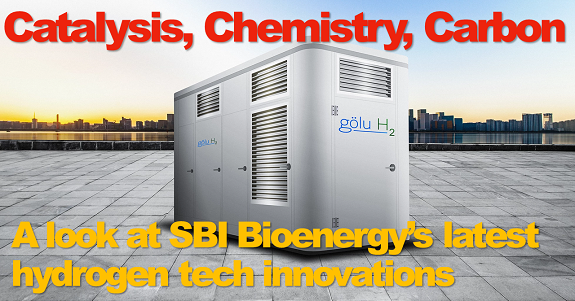Catalysis, Chemistry, Carbon – SBI BioEnergy’s Competitive Edge
Q: What was the reason for founding your organization – what was the open niche you saw that could be addressed with a new product or service? What was the problem, or gap, or opportunity?
SBI is a leading innovator in clean alternative fuels. The core technologies are based on catalysis, with engineering and chemistry driving the improvements to the intended results. We have developed a renewable diesel and biodiesel process with great success since it was licensed by Shell.
We now have developed a new technology solving the biggest barriers for widespread hydrogen adoption. Currently, global hydrogen demand is 70 MMT, with 95% of this hydrogen being produced by a high carbon, non-renewable methane based Steam Methane Reforming process (SMR). SBI’s Gölu H2 process removes the reliance on a fossil fuel, and uses ethanol and water to produce carbon-neutral hydrogen. With Gölu’s carbon capture partnering technologies, our hydrogen is the first carbon-negative hydrogen production process in the world.
Q: Tell us about your organization. What do you do?
We produce technologies, our latest tech we are promoting is a green hydrogen production process creating fuel-cell grade hydrogen from ethanol and water. We have scaled up from milligrams to grams and now 25kg/day units. Our latest unit in development will be used as a module to combine and develop into larger capacity units.
Q: What stage of development are you?
Demonstration stage – proven at small, integrated scale, but not yet commercially available
Q: What do your technologies, products or services do and accomplish – how does it (they) work, who is it (they) aimed for?
Our reactor makes accessible, low cost, zero carbon hydrogen a reality. Costly storage tanks can be optimized to hold only the required quantity of hydrogen, while the rest is produced on-demand from stored ethanol. Ethanol is much easier to store and transport using existing infrastructure as opposed to making expensive upgrades to be able to carry and store hydrogen safely.
Municipalities are under pressure to decarbonize, but don’t have the electrical capacity to charge their electric fleets. Our solution produces its own electricity from a readily available renewable resource, ethanol, while producing electricity or hydrogen, depending on what is required. Refueling stations can produce hydrogen until their storage is full, then switch to producing electricity, and depending on the location push electricity to the grid for continuous revenue generation, clean electricity generation, and carbon-credits. Alternatively, some places allow hydrogen to offset Natural Gas pipelines.
Q: Competitively, what gives your technology, product or service set an edge in cost or performance, sustainability, or any other aspect, that makes it stand out from the crowd, In short, what makes it transformative?
We have run our hydrogen generator for over 1 year continuously with no signs of degradation to our catalyst. With no moving parts aside from feed pumps for the water and ethanol this means there are no moving parts in the reactor and ultimately no points of failure with minimal maintenance required. Our system is equipped with data logging automation software, which reveals if and when there are any performance concerns and allows for pre-emptive maintenance scheduling. Our system can also be accessed remotely for any issues, for a quick and accurate troubleshooting response.
Q: What are the 3 top milestones you have accomplished in the past 3 years?
1. We have run for over 1 year with no issues to the catalyst.
2. We have successfully scaled up to 25kg/day capacity.
3. We have integrated our hydrogen with a fuel cell to produce electricity for over 6 months with no degradation to the fuel cell.
Q: What are the 3 top milestones you will accomplish in the next 3 years?
We will have:
1. A 1 T unit by next year and a 10 T unit by 2023.
2. A combined system with carbon capture implemented for the world’s first carbon-negative hydrogen production process.
3. Golu H2 Flex stations (refueling for hydrogen and electricity) throughout the UK and USA.
Q. Where can I learn more about SBI BioEnergy?
Category: Top Stories

















